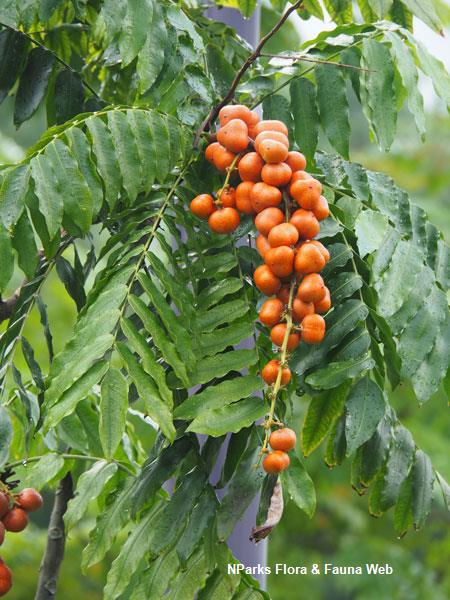.jpg)
Back
Lepisanthes rubiginosa (Roxb.) Leenh.
| Family Name: | Sapindaceae |
| Common Name: | Mertajam, Kelat Layu, Terajah, Terajan |
Name
Classifications and Characteristics
| Plant Division | Angiosperms (Flowering Seed Plants) |
|---|---|
| Plant Growth Form | Tree |
| Mode of Nutrition | Autotrophic |
| Maximum Height | 16 m |
Biogeography
| Native Distribution | From northern India to Indo-China, South-East China, Malesia and North-West Australia. |
|---|---|
| Native Habitat | Terrestrial |
| Preferred Climate Zone | Tropical |
| Local Conservation Status | Native to Singapore (Least Concern (LC)) |
Description and Ethnobotany
| Growth Form | It is a shrub or small tree, up to 16 m tall and 28 cm dbh. Brown hairs are present in the young branches, inflorescences and leaf stalks. |
|---|---|
| Foliage | Leaf is compound (15 – 50 cm long), comprising of (2–) 3 – 6 (–9) pairs of leaflets, and often has a pseudoterminal leaflet. Leaflet is elliptic to lanceolate shaped, (4.5–) 6.5 – 18 (–25) cm long and (2–)3.5 – 8.5 (–11) cm wide). Leaflet is grey-green on the upper side and yellow-green on the underside with 8 – 12 (–16) of secondary veins. Leaf tip is obtuse to acute while leaf base is rounded to broadly cuneate. Leaf stalk (petiole) 7.5 –12 (–20) cm long. Brown hairs are present on both upper and lower side of the leaves, especially on the midrib and veins and leaf stalk, giving a velvety texture. |
| Flowers | Inflorescence is branched once (racemose), about 25 – 35 (– 50) cm long and sweet-scented. Flowers are white to yellow-white, and sparsely hairy on the sepals, petals, stalk and ovary. Each flower comprises of 5 slightly concave sepals, 4 – 5 petals and white flattened filaments, where male flowers have slightly longer filaments ((0.15–) 0.3 – 0.5 cm long) compared to female flowers (about 0.15 cm long). Ovary is 3-lobed, 0.12 - 0.18 cm long and 0.2 – 0.22 cm wide. |
| Fruit | Fruit is 1 to 3 lobed (0.8 – 1.3 cm long and 0.7– 0.8 cm wide) with a ridge along the middle of each lobe (carinate). Fruit turns dark purple or black when ripe. Seed is oblong-ellipsoid (0.9 – 1.1 cm long and 0.4 cm wide). |
| Habitat | It is found in secondary rainforest, shrub land, along forest margins, along river banks, up to 1200m altitude. |
| Cultivation | It prefers well-drained soil but can tolerate nutrient-deficient soil and short period of waterlogging. |
| Etymology | Genus Lepisanthes is Latin for scaly flowers, which refers to the presence of scales on the inner surface of the flower petals. Species rubiginosa is Latin for rust-coloured, which refers to the brown coloured hairs on the leaflets and twigs. |
| Ethnobotanical Uses | Edible Plant Parts : Edible Fruits Medicinal: A decoction of roots and leaves are reportedly used in folk medicine to treat fever. Timber & Products: The timber is used for firewood or to make tool-handles or rice-pounders. Others: In Java, young leaves are cooked and eaten as vegetable, and ripe fruits are reportedly edible, sweet tasting yet astringent. |
Landscaping Features
| Desirable Plant Features | Fragrant |
|---|---|
| Landscape Uses | Parks & Gardens, Reforestation |
Plant Care and Propagation
| Light Preference | Full Sun |
|---|---|
| Water Preference | Moderate Water |
| Plant Growth Rate | Moderate |
Image Repository
Others
| Master ID | 2005 |
|---|---|
| Species ID | 3297 |
| Flora Disclaimer | The information in this website has been compiled from reliable sources, such as reference works on medicinal plants. It is not a substitute for medical advice or treatment and NParks does not purport to provide any medical advice. Readers should always consult his/her physician before using or consuming a plant for medicinal purposes. |

.jpg)
.jpg)

